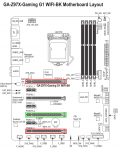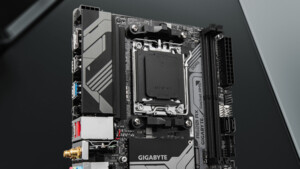unreality
Lt. Junior Grade
- Registriert
- Aug. 2011
- Beiträge
- 406
Hallo Leute,
Ich habe mal eine Frage. Am Montag wird mein neues Board hier ankommen. Habe mir ein GA-Z97X-Gaming G1 WIFI-BK gegönnt.
Meine Frage ist nun ob ich meine beiden 780Ti frei auf dem Board platzieren kann. Die Karten sollen natürlich im SLI laufen und möglichst viel Platz zwischen sich haben (zwecks Kühlung). Dass mindestens PCIe 3.0 x8 an Bandbreite vorhanden sein soll ist klar, da ich aber die Möglichkeit habe 2x 3.0x16 zu nutzen oder 1x 3.0x16 und 1x3.0x8 (dafür mehr Platz) halte ich letzteres für optimaler.
Die Mainboard Anleitung empfiehlt allerdings erstere Variante. Anbei mal noch der Aufbau des Boards aus der Anleitung:

Empfohlen wird die Kombination ROT + GRÜN
Ich würde aber gerne ROT + ROT nutzen. Geht das in Ordnung, wenn die Bandbreite stimmt?
Cheers,
unreality
Ich habe mal eine Frage. Am Montag wird mein neues Board hier ankommen. Habe mir ein GA-Z97X-Gaming G1 WIFI-BK gegönnt.
Meine Frage ist nun ob ich meine beiden 780Ti frei auf dem Board platzieren kann. Die Karten sollen natürlich im SLI laufen und möglichst viel Platz zwischen sich haben (zwecks Kühlung). Dass mindestens PCIe 3.0 x8 an Bandbreite vorhanden sein soll ist klar, da ich aber die Möglichkeit habe 2x 3.0x16 zu nutzen oder 1x 3.0x16 und 1x3.0x8 (dafür mehr Platz) halte ich letzteres für optimaler.
Die Mainboard Anleitung empfiehlt allerdings erstere Variante. Anbei mal noch der Aufbau des Boards aus der Anleitung:

Empfohlen wird die Kombination ROT + GRÜN
Ich würde aber gerne ROT + ROT nutzen. Geht das in Ordnung, wenn die Bandbreite stimmt?
Cheers,
unreality



